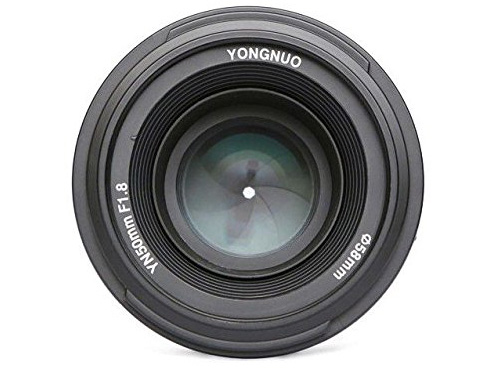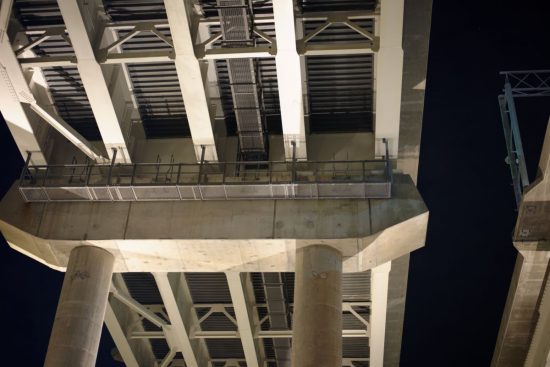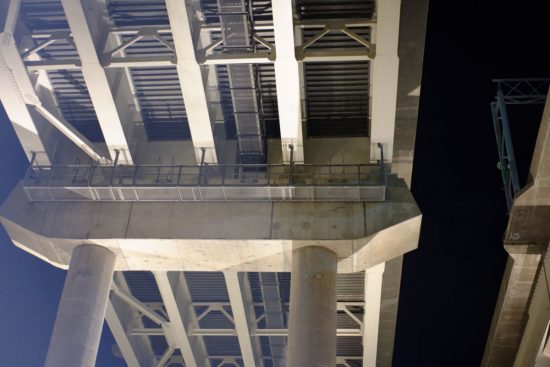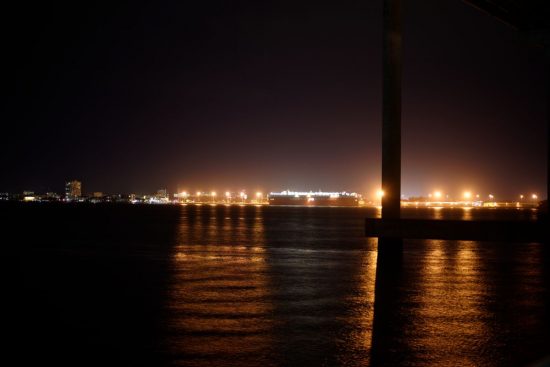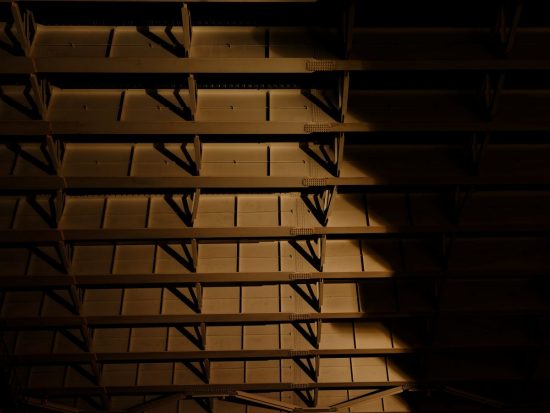This review of the Yongnuo YN 50mm f/1.8 lens for F-mount ($72.50) and comparison with the Nikon 50mm f/1.8G lens ($216.95) is written by www.shuttersinthenight.com:
Yongnuo, initially famous for their incredibly affordable flashes and off-camera triggers, caused quite a stir when it moved into lenses, for two reasons: (1) They came out at unheard-of price points, some below $100, and (2) they were, at least externally, blatant copies of existing Nikon and Canon designs.
Then again, #2 shouldn’t have been a huge surprise considering much of Yongnuo’s lighting equipment takes (ok, basically steals) exterior design from Canon and Nikon offerings.
Sketchy design aside, given how affordable Yongnuo’s lenses are, and that they’re mainly large-aperture primes, I thought it’d be valuable to find out how good they really are. If the image quality is comparable with pricier Nikon, Canon, Sigma, or Tamron lenses, nighttime photographers on a budget should be extremely interested: that means Yongnuo has made large-aperture primes—which are extremely effective for low-light photography—accessible to a much larger audience than before, including beginners and students.
To get a feel for Yongnuo’s lens savvy, I pitted the Yongnuo YN50mm F1.8, currently selling for $68.99, against the proven Nikon AF-S Nikkor 50mm f/1.8G, which sells for $219.95. Identical specs, but the Yongnuo is 1/3 the price, making it a trivial addition to your shopping cart (but one that’ll make a huge difference in low-light!) after spending several hundred on a Nikon DSLR and 18-55mm kit lens. But how much of a real-world image quality difference is there between the two? To find out, I shot a few nighttime comparison scenes:
(But before that, exactly how much of an external copy is the Yongnuo? You can actually fit the Nikon lens hood for Nikon’s 50mm on it, and it fits perfectly, snugly snapping on and off:)
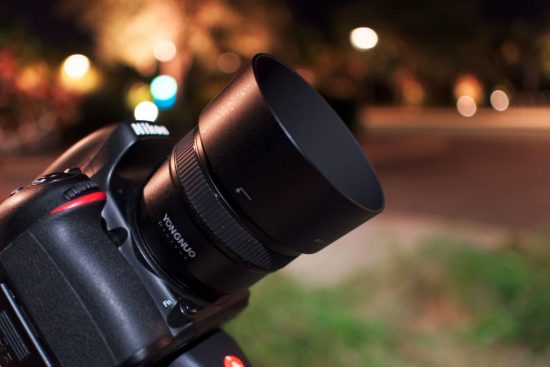
Nikon hood on Yongnuo lens. The exterior plastics feel very similar too.
Scene 1: Resolution
In this series of photos, the raw resolution of the two lenses at different apertures is tested.
First, an overview of the whole frame:
It’s pretty obvious these don’t look the same. There’s a massive amount of flare on the left side of the Yongnuo shot, caused by a streetlight to the left of the frame. This didn’t seem to affect the Nikon, which apparently has much better flare control, at all. The lens hood wasn’t used on either lens, as the Yongnuo is not sold with a lens hood. That being said, a third-party lens hood (or even the Nikon hood, as it fits perfectly) may be a necessity, or at least a worthwhile investment, for Yongnuo owners.
Moving on to full-size crops for judging resolution:
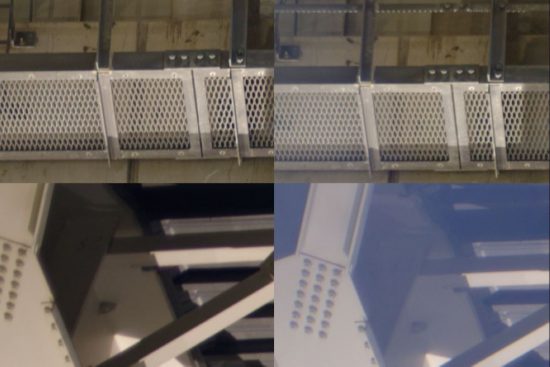
Scene 1 at f/1.8. Top: Center crop, Bottom: Corner crop. Left: Nikon, Right: Yongnuo.
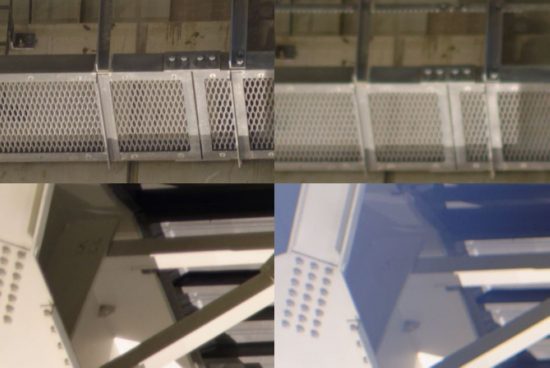
Scene 1 at f/2.8. Top: Center crop, Bottom: Corner crop. Left: Nikon, Right: Yongnuo.
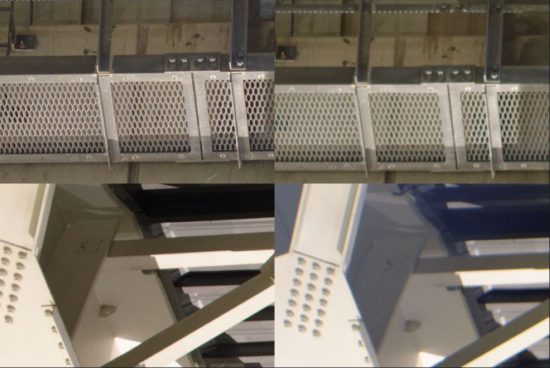
Scene 1 at f/4.0. Top: Center crop, Bottom: Corner crop. Left: Nikon, Right: Yongnuo.
At f/1.8, disregarding the flare, the two lenses are actually surprisingly close, rendering the grating in the center of frame with nearly equal clarity. The bolts in the far corner of frame too; the Yongnuo actually resolves them slightly more clearly. At f/2.8, though, it’s no contest because the Yongnuo suffers from focus shift that destroys the center clarity; the corner isn’t affected as severely. At f/4.0 the Nikon really stands out, delivering both incredible center and corner sharpness. f/4.0 on the Yongnuo is, disappointingly, not much of an improvement over f/1.8. Overall, the Yongnuo seems optimized to keep up with the Nikon at f/1.8, with smaller apertures neglected. For nighttime photographers, this isn’t necessarily a dealbreaker.
Scene 2: Resolution and Harsh Light
In this series of photos, the raw resolution of the two lenses, as well as the way they deal with direct lighting, is tested. Some lenses lose sharpness or form rings, flare, or haziness around direct light.
First, an overview of the whole frame as shot by each lens:
Faint streaks, especially in the water in front of the ship on the right, and in the right side of the sky, show that the Yongnuo lens also has a negative reaction to harsh light sources within the frame. The Nikon lens doesn’t appear to be affected by this at all. While this is less severe than the flare caused by out-of-frame light sources at a sharp angle to the lens, as seen in Scene 1, there is no way to prevent these imperfections, aside from being a master at Photoshop. The coatings or lens design features that prevent flare and light rings seem to be one of the things Yongnuo left off to get the YN50mm to its price point.
Moving on to full-size crops for judging resolution:

Scene 2 at f/1.8. Top: Center crop, Bottom: Corner crop. Left: Nikon, Right: Yongnuo.
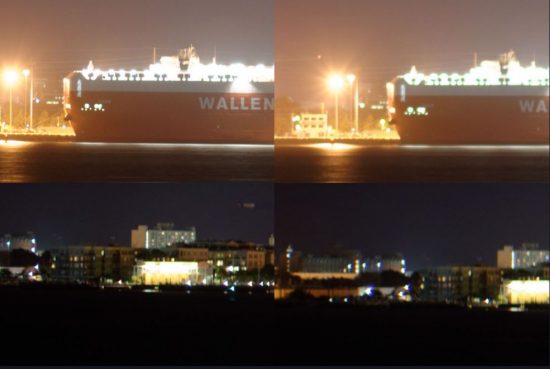
Scene 2 at f/2.8. Top: Center crop, Bottom: Corner crop. Left: Nikon, Right: Yongnuo.
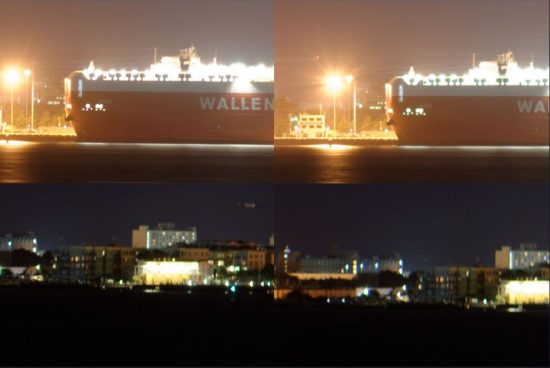
Scene 2 at f/4.0. Top: Center crop, Bottom: Corner crop. Left: Nikon, Right: Yongnuo.
Both lenses suffer from purple fringing, as shown by the purple edge to the cargo ship’s deck lighting, at f/1.8. They’re also neck-and-neck as far as resolution, same as with Scene 1. Purple fringing disappears on both lenses at f/2.8, a welcome observation. The focus shifting hurts the Yongnuo again at f/2.8, and the performance is similar to Scene 1 at f/4.0 as well: the Nikon is tack-sharp, while the Yongnuo’s performance is similar to at f/1.8 (which isn’t bad; but a 50mm f/1.8 should really be better at f/4.0). I believe the Yongnuo is still suffering some minor focus shifting effect at f/4.0 (note that it was focused for the first test photo at f/1.8, then focus was locked; same focusing approach was used on the Nikon).
Scene 3: Bokeh
Bokeh is the quality and intensity of the out-of-focus areas of images. Good bokeh is what’s responsible for making portraits “pop” with a distinct separation between the person and their surroundings. Different lenses render bokeh differently, some are said to have smooth or “creamy” bokeh, while others have harsh or “busy” bokeh. Shallow depth-of-field, and the resulting extreme bokeh, is one of the draws of large-aperture lenses (the other being greater light-gathering ability or brightness), so I wanted to test how the two lenses compared with bokeh as well.

Bokeh test scene, uncropped. Top: f/1.8, Bottom: f/2.8. Left: Nikon, Right: Yongnuo.
Very little separates the lenses’ bokeh at f/2.8, while at f/1.8 the Nikon has slightly smoother bokeh with less of a border around the circles, and slightly larger circles too. While the difference is still slight, these characteristics will help produce a more pleasing background to portraits or close-up photos.
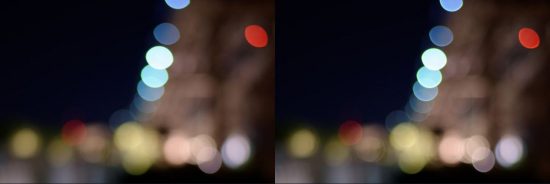
Bokeh detail at f/1.8. Left: Nikon, Right: Yongnuo
Conclusion
Using the Yongnuo lens was more of an adventure than expected, as it has unique performance. Here’s a bulleted summary of what I found about the lens:
- Thought it’d be weak at f/1.8, but it truly performed really well at its maximum aperture when it comes to resolution; this is where “budget” lenses usually fall apart!
- Lens flare seems like it’d be a constant battle if you used this lens daily, and is where the low price of the lens is most obvious.
- Focus shifting means the lens is likely best used in Live View or manual focus; traditional DSLR autofocus will be tripped up by the focus shift. This limits the usefulness of the lens as it’ll be tough to capture fast action.
Given the results of the review, here are some purchasing recommendations:
- Should you pick the Yongnuo 50mm over the Nikon 50mm? If the price makes a difference for you, then yes – it’s still a good lens that can produce amazing images, although it’ll be harder to live with due to its issues.
- Should you pick the Yongnuo 50mm over an older, used Nikon 50mm (perhaps the 50mm f1/.8D)? Harder to say – a used Nikon will still be more expensive ($100-150), but it’ll be a meaningfully better lens.
- Here’s what you should really do though: Get a Nikon 50mm, since those are already really cheap — buy used if you have to. But, buy Yongnuo if you’re looking for a cheap 35mm or 85mm, because the price difference between the Yongnuo and name brand versions of those lenses are much steeper (Nikon’s 35mm f/1.8G ED is $530, while Yongnuo’s YN35mm F2 is $88!)
Here’s another sample image from the Yongnuo – in conditions it likes, it can definitely produce great images. In this shot, it didn’t have to deal with flare from any strong light sources in or out of the frame. Again, the tradeoffs that Yongnuo lenses seem to have aren’t as worthwhile at the 50mm lens price point, but at 35mm or 85mm they’re definitely worth strong consideration.
This article was originally published here. If you have an interesting idea for a guest post, you can contact me here.
